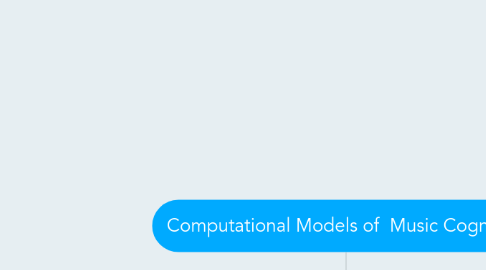
1. Gestalt Principle
1.1. Proximity
1.2. Similarity
2. Computer Models
2.1. Algorithms
2.1.1. Grouping
2.1.1.1. LBDM
2.1.1.1.1. Proximity rule
2.1.1.1.2. Similarity - Change rule
2.1.1.1.3. Weighted Average Derivation
2.1.2. Expectation
2.1.2.1. Static Model
2.1.2.1.1. Schellenberg - 2 Factor Model
2.1.2.2. Trained Model
2.1.2.2.1. Huron
2.1.2.3. Testing the Model - Probe Tone
2.1.3. Key Signature
2.1.3.1. K & S Algorithm
2.1.3.1.1. Profiling of 24 sets of key
2.1.3.1.2. Profile the test set
2.1.3.1.3. Correlate the test set profile with 24 set of profile
2.2. Motivation: Why do we want to create computer models?
2.2.1. Algorithmic Composition
2.2.1.1. New Music Structure
2.2.1.2. New Genre
2.2.1.3. New Compositional Technique
2.2.2. Design of Compositional Tools
2.2.2.1. The Pipeline of Music Creation
2.2.2.2. Tools to help musician
2.2.3. Computational Music Analysis
2.2.3.1. To propose and verify Hypothesis
2.2.3.2. Analysis By Synthesis
2.2.3.3. Analysis By Decomposition
2.2.4. Music Cognition
2.2.4.1. Understand How The Mind Work
2.2.4.2. Music Improvisation
3. Mind
3.1. Music Cognition
3.1.1. Perception of Grouping of Structure in Music
3.1.2. Melodic Pitch Expectation
3.1.3. Key Finding
3.1.4. Marr 3 level
4. Music
4.1. Representation
4.1.1. Symbolic (High level abstraction)
4.1.1.1. Musical Score
4.1.1.2. Midi Files, MusicXML
4.1.1.3. Musical Surface
4.1.1.3.1. Onset
4.1.1.3.2. Pitch
4.1.1.3.3. Duration
4.1.1.3.4. IOI
4.1.1.3.5. Rest
4.1.1.3.6. Contour
4.1.1.3.7. Scale Degree
4.1.2. Non-Symbolic
4.1.2.1. wav files, MP3, Aiff, ogg (Low Abstraction, precise)
